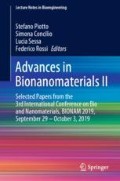Abstract
This study aimed to tune the release of non-steroidal, antiinflammatory and antimicrobial diclofenac sodium salt from a bactericidal, pH-sensitive polymer matrix in view of the development of a synergic and combined therapy.
The polymer matrix was represented by A(BC)n linear or branched copolymers (n = 1, 2) synthesized by Atom Transfer Radical coPolymerization (ATRP). Manufactures were obtained and analysed in film form, using solvent casting technique.
2-(dimethylamino) ethyl methacrylate (DMAEMA), 2-(diethylamino) ethyl methacrylate (DEAEMA) and 2-(diisopropylamino) ethyl methacrylate (DIPAEMA) have been used as comonomer bearing the bactericidal amino-groups and to modulate the pH-sensitivity of the material. The electrolytic and structural factors of the amino-groups, juxtaposed with the copolymer structure, gave raise to different interactions with the negatively charged diclofenac and imparted a finer control on the drug release kinetics. Data evidenced that copolymers with DMAEMA released diclofenac faster than those with DEAEMA and DIPAEMA; thus, the lower was the amine Kb, the faster was the release. The correlation between copolymer structure and kinetic/equilibrium of the drug release was analysed and correlated with the Tg of copolymers when diclofenac was loaded.
Access this chapter
Tax calculation will be finalised at checkout
Purchases are for personal use only
References
Tashiro, T.: Antibacterial and bacterium adsorbing macromolecules. Macromol. Mater. Eng. 286, 63–87 (2001)
Grapski, J.A., Cooper, S.L.: Synthesis and characterization of non-leaching biocidal polyurethanes. Biomaterials 22, 2239–2246 (2001)
Chen, C.Z., Cooper, S.L.: Interactions between dendrimer biocides and bacterial membranes. Biomaterials 23, 3359–3368 (2002)
Kenawy, E.-R., Mahmoud, Y.A.-G.: Biological active polymers, synthesis and antimicrobial activity of some linear copolymers with quaternary ammonium and phosphonium groups. Macromol. Biosci. 3, 107–116 (2003)
Kenawy, E.-R., Worley, S.D., Broughton, R.: The chemistry and applications and antimicrobial polymers: a state-of-the-art review. Biomacromolecules 8, 1359–1384 (2007)
Waschinski, C.J., Barnert, S., Theobald, A., Schubert, R., Kleinschmidt, F., Hoffmann, A., Saalwächter, K., Tiller, J.C.: Insights in the antibacterial action of poly(methyloxazoline)s with a biocidal end group and varying satellite groups. Biomacromolecules 9, 1764–1771 (2008)
Mella, M., Tagliabue, A., Mollica, L., Izzo, L.: Monte Carlo study of the effects of macroion charge distribution on the ionization and adsorption of weak polyelectrolytes and concurrent counterion release. J. Colloid Interface Sci. 560, 667–680 (2020)
Duncan, R., Izzo, L.: Dendrimer biocompatibility and toxicity. Adv. Drug Deliv. Rev. 57, 2215–2237 (2005)
Kügler, R., Bouloussa, O., Rondelez, F.: Evidence of a chargedensity threshold for optimum efficiency of biocidal cationic surfaces. Microbiology 151, 1341–1348 (2005)
Murata, H., Koepsel, R.R., Matyjaszewski, K., Russell, A.J.: Permanent, non-leaching antibacterial surfaces-2: how high density cationic surfaces kill bacterial cells. Biomaterials 28, 4870–4879 (2007)
Vigliotta, G., Mella, M., Rega, D., Izzo, L.: Modulating antimicrobial activity by synthesis: dendritic copolymers based on nonquaternized 2-(Dimethylamino)ethyl methacrylate by Cu-mediated ATRP. Biomacromol 13, 833–841 (2012)
Matrella, S., Vitiello, C., Mella, M., Vigliotta, G., Izzo, L.: The role of charge density and hydrophobicity on the biocidal properties of self-protonable polymeric materials. Macromol. Biosci. 15, 927–940 (2015)
Izzo, L., Matrella, S., Mella, M., Benvenuto, G., Vigliotta, G.: Escherichia coli as a model for the description of the antimicrobial mechanism of a cationic polymer surface: cellular target and bacterial contrast response. ACS Appl. Mater. Interfaces 11, 15332–15343 (2019)
De Rosa, M., Vigliotta, G., Soriente, A., Capaccio, V., Gorrasi, G., Adami, R., Reverchon, E., Mella, M., Izzo, L.: Leaching or not leaching: an alternative approach to antimicrobial materials via copolymers containing crown ethers as active groups. Biomater. Sci. 5, 741–751 (2017)
Yin, Z., Wang, Y., Whittel, L.R., Jergic, S., Liu, M., Harry, E., Dixon, N.E., Kelso, M.J., Beck, J.L., Oakley, A.J.: DNA replication is the target for the antibacterial effects of nonsteroidal anti-inflammatory drugs. Chem. Biol. 21, 481–487 (2014)
Mella, M., Mollica, L., Izzo, L.: Influence of charged intramolecular hydrogen bonds in weaks polyelectrolytes: a monte carlo study of flexible and extendible polymeric chains in solution and near charged sphere. J. Polym. Sci. Part B: Polym. Phys. 53, 650–663 (2015)
Mella, M., Izzo, L.: Modulation of ionization and structural properties of weak polyelectrolytes due to 1D, 2D and 3D confinement. J. Polym. Sci. Part B: Polym. Phys. 55, 1088–1102 (2017)
Tagliabue, A., Izzo, L., Mella, M.: Absorbed weak polyelectrolytes: impact of confinement, topology, and chemically specific interactions on ionization, conformation free energy, counterion condensation, and absorption equilibrium. J. Polym. Sci. Part B: Polym. Phys. 57, 491–510 (2019)
Tagliabue, A., Izzo, L., Mella, M.: Impact of charge correlation, chain rigidity, and chemical specific interactions on the behavior of weak polyelectrolytes in solution. J. Phys. Chem. B 123, 8872–8888 (2019)
Author information
Authors and Affiliations
Corresponding author
Editor information
Editors and Affiliations
Rights and permissions
Copyright information
© 2020 Springer Nature Switzerland AG
About this paper
Cite this paper
Izzo, L., Gorrasi, G., Sorrentino, A., Tagliabue, A., Mella, M. (2020). Controlling Drug Release of Anti-inflammatory Molecules Through a pH-Sensitive, Bactericidal Polymer Matrix: Towards a Synergic and Combined Therapy. In: Piotto, S., Concilio, S., Sessa, L., Rossi, F. (eds) Advances in Bionanomaterials II. BIONAM 2019 2019. Lecture Notes in Bioengineering. Springer, Cham. https://doi.org/10.1007/978-3-030-47705-9_14
Download citation
DOI: https://doi.org/10.1007/978-3-030-47705-9_14
Published:
Publisher Name: Springer, Cham
Print ISBN: 978-3-030-47704-2
Online ISBN: 978-3-030-47705-9
eBook Packages: EngineeringEngineering (R0)

